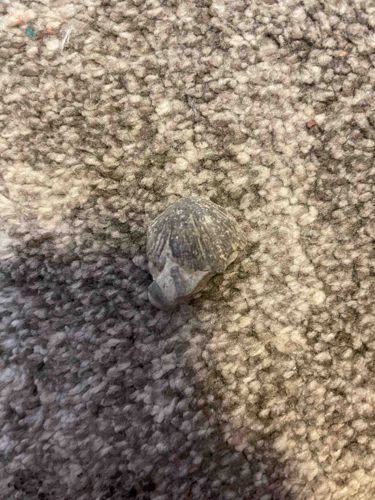
Fossil Brachiopod
This item appears to be a fossilized brachiopod, specifically from the Articulata class, characterized by its hinged shell. The dominant color is a dull, muted grey, indicating mineralization over a geological timescale. Its approximate size is small, likely fitting within the palm of a hand, though exact dimensions are not discernible from the image. The shell exhibits prominent, raised radial ribs that emanate from the hinge area and extend towards the anterior margin, a common feature in many brachiopod species. These ribs are relatively finely spaced and uniform across the visible surface. A distinct hinge line is present, though the full articulation mechanism is not clearly visible. The overall shape is biconvex or plano-convex, with a slightly rounded or elongated profile. The material appears to be a type of stony or silty matrix, consistent with sedimentary fossilization. There are no obvious signs of recent damage, repairs, or significant wear beyond what would be expected from millions of years of fossilization and erosion. The surface texture is somewhat granular, and minimal details are obscured by what might be adhering sediment or matrix. No specific maker’s marks, signatures, or stamps are present, as this is a natural specimen. Given the commonality of ribbed brachiopods in the fossil record, it likely dates to the Paleozoic Era, potentially from the Devonian or Carboniferous periods, but a more precise age would require geological context or species-specific identification. The preservation quality seems moderate, with good retention of the shell's morphology, which indicates a relatively stable burial environment during fossilization.
AI-Generated Appraisal Disclaimer
Estimated Value
$30-75
Basic Information
Category
Fossil
Appraised On
December 1, 2025
Estimated Value
$30-75
Item Description
This item appears to be a fossilized brachiopod, specifically from the Articulata class, characterized by its hinged shell. The dominant color is a dull, muted grey, indicating mineralization over a geological timescale. Its approximate size is small, likely fitting within the palm of a hand, though exact dimensions are not discernible from the image. The shell exhibits prominent, raised radial ribs that emanate from the hinge area and extend towards the anterior margin, a common feature in many brachiopod species. These ribs are relatively finely spaced and uniform across the visible surface. A distinct hinge line is present, though the full articulation mechanism is not clearly visible. The overall shape is biconvex or plano-convex, with a slightly rounded or elongated profile. The material appears to be a type of stony or silty matrix, consistent with sedimentary fossilization. There are no obvious signs of recent damage, repairs, or significant wear beyond what would be expected from millions of years of fossilization and erosion. The surface texture is somewhat granular, and minimal details are obscured by what might be adhering sediment or matrix. No specific maker’s marks, signatures, or stamps are present, as this is a natural specimen. Given the commonality of ribbed brachiopods in the fossil record, it likely dates to the Paleozoic Era, potentially from the Devonian or Carboniferous periods, but a more precise age would require geological context or species-specific identification. The preservation quality seems moderate, with good retention of the shell's morphology, which indicates a relatively stable burial environment during fossilization.
Related Tags
Explore similar items and categories:
Get Your Items Appraised
Instant estimates of your treasures with AI-powered instant appraisals